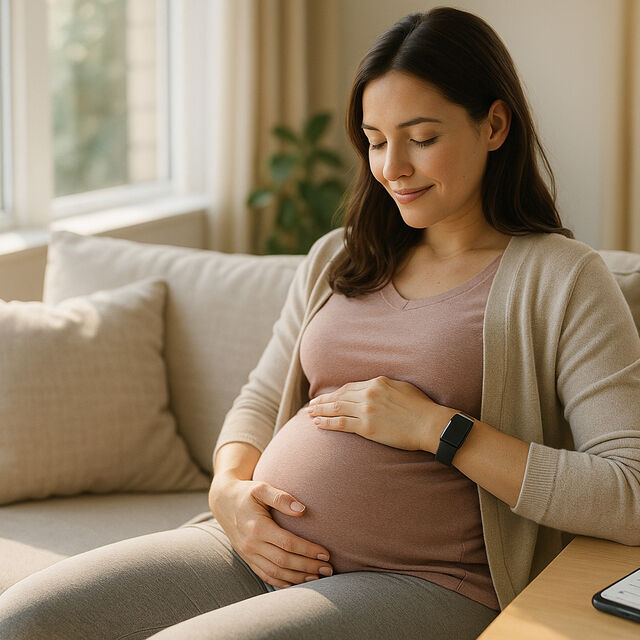Technology in Pregnancy and How Wearable Health Trackers Can Help
Key Takeaways
Wearable health trackers provide continuous, real-time insights into vital signs like heart rate, sleep, and activity, empowering expecting mothers to actively monitor their health. This data can help detect potential complications early and improves communication with healthcare providers. By integrating with prenatal services, these devices offer a proactive approach to managing maternal and fetal well-being.
Key Health Metrics Monitored by Wearables
Modern wearable devices have become invaluable for tracking several health metrics, especially during pregnancy. These devices provide insights into both physical and emotional health, helping expectant mothers make informed decisions throughout this transformative time. One of the most critical areas of focus is heart rate data, which can reveal early signs of potential issues.
Heart Rate and Heart Rate Variability
Heart rate and heart rate variability (HRV) are two essential metrics wearable devices can monitor during pregnancy. HRV measures the time intervals between heartbeats, offering a glimpse into how well the autonomic nervous system is managing stress.
During pregnancy, heart rate typically increases after conception, peaks around two weeks later, briefly dips, and then rises again until just before delivery. Meanwhile, HRV tends to decline until about 33 weeks of pregnancy before beginning to recover.
A study conducted by WHOOP Inc. between March 2021 and October 2022 analyzed data from 241 participants across 42 U.S. states and 16 other countries. The findings showed that maternal HRV decreases during pregnancy until about 33 weeks, after which it starts to rise. Importantly, the study also discovered that changes in nighttime HRV could act as a digital biomarker for detecting the risk of preterm delivery.1
This is particularly critical given that the U.S. singleton preterm birth rate is 8.42%2. By spotting early shifts in HRV, healthcare providers can identify mothers who may need further evaluation or interventions, such as progesterone treatments to delay labor or corticosteroids to support fetal development.
Sleep Quality and Sleep Patterns
Sleep often becomes more challenging as pregnancy progresses, making sleep tracking one of the most beneficial features of wearables. Approximately 80% of pregnant women experience sleep disturbances, which can have serious health consequences for both mother and baby.
Wearable devices monitor metrics like total sleep time, sleep stages, deep sleep, and periods of wakefulness. This data is vital because poor sleep during pregnancy has been linked to risks like preeclampsia, gestational diabetes, prolonged labor, and higher rates of cesarean sections.3
As Jodi A. Mindell, PhD, a psychology professor at St. Joseph's University, explains:
Thanks to surging hormones, sleep disturbances may begin right at the start of pregnancy.
By tracking sleep patterns, wearables help expectant mothers identify issues and make adjustments. For example, they can pinpoint whether you’re getting enough deep sleep or identify factors disrupting your rest. This information can guide changes to bedtime routines or sleep environments to improve overall rest.
Physical Activity and Movement Tracking
Monitoring physical activity during pregnancy is just as important as tracking heart and sleep data. Staying active benefits both the mother and baby, but it’s essential to do so safely. Wearables make this easier by tracking steps, distance, calories burned, and exercise intensity.
These devices provide insights into daily movement patterns and how activity levels shift throughout pregnancy. Many wearables even offer pregnancy-specific recommendations, like reminders to move after long periods of inactivity, which can help improve circulation and overall health.
By keeping an eye on activity data, mothers-to-be can identify the best times to exercise and adjust their routines based on energy levels and how their body responds.
Stress Monitoring and Mental Health Insights
Stress management is another area where wearables shine. Devices equipped with EDA (electrodermal activity) sensors can measure stress levels by tracking changes in heart rate and respiratory rate. Research shows that stress can increase heart rate by an average of 1.40 bpm and respiratory rate by 0.20 breaths per minute.4
A study by Jang et al. introduced a graphene e-tattoo (GET) system capable of delivering high-fidelity EDA signals while minimizing motion-related interference. This system performed consistently during various activities over a 15-hour period and closely matched the accuracy of traditional EDA sensors.5
Many wearables also offer tools like guided breathing exercises and meditation prompts to help manage stress in real time. These features empower expectant mothers to take proactive steps to support their mental well-being.
Advanced Metrics: Blood Pressure, Glucose, and Contraction Tracking
Some advanced wearables go even further, monitoring blood pressure, glucose levels, and contractions. Blood pressure tracking is particularly helpful for identifying conditions like pregnancy-induced hypertension or preeclampsia. Real-time data analysis, often powered by AI, can alert users and healthcare providers to potential complications early on.
For women with gestational diabetes, certain wearables can integrate with continuous glucose monitors to track blood sugar levels throughout the day. This helps identify how diet, activity, and stress impact glucose control.
Specialized pregnancy wearables may also include contraction tracking, which monitors the frequency, duration, and intensity of contractions as delivery approaches. By integrating these advanced metrics with healthcare systems, providers can offer more personalized care and address potential issues before they escalate into serious complications.
---Benefits of Wearable Health Trackers for Expecting Mothers
Wearable health trackers go beyond simply collecting data - they provide expecting mothers with practical insights, timely warnings, and tailored guidance to support both their health and that of their baby. These tools can make the journey through pregnancy safer and more reassuring.
Early Detection of Potential Health Complications
One of the standout advantages of wearable devices is their ability to establish individual baselines for vital signs and detect any deviations that might indicate complications. This kind of continuous monitoring can catch subtle changes that might otherwise go unnoticed. For example, research has shown that wearables can identify significant differences in heart and breathing rates between pregnant women with and without intraamniotic infection6. This means potential issues can be flagged in real time, prompting early consultations with healthcare providers - an especially valuable feature for high-risk pregnancies. Studies even suggest that wearables can often predict acute illnesses faster than relying on symptom reporting alone.7
Personalized Feedback for Energy, Nutrition, and Sleep
Wearables also offer practical, day-to-day guidance tailored to the needs of pregnant women. For instance, smartwatches can remind users to stay hydrated, helping them meet the recommended 8–12 glasses of water per day - a critical need during pregnancy, as blood volume can increase by as much as 50%. These devices also analyze sleep patterns, identifying issues like insomnia or sleep apnea and suggesting adjustments to improve rest. Additionally, by tracking metrics such as heart rate and blood pressure, wearables can help women recognize when to slow down and set realistic activity goals. A study in the Journal of Medical Internet Research highlighted how wearables significantly improved maternal health outcomes by enabling better monitoring and early detection of potential problems.8
Building Maternal Confidence and Peace of Mind
For many expecting mothers, pregnancy comes with a fair share of anxiety. Wearables help alleviate this by providing real-time health insights. By establishing a personalized health baseline, these devices allow women and their healthcare providers to distinguish between normal pregnancy changes and potential concerns. Many women report feeling more in control and less stressed when using wearables, as the data shifts their focus from vague worries to clear, actionable information.
Healthcare professionals also see the psychological benefits. Jenna Wallace, a pediatric psychologist at WVU, explains:
The data we are gathering can help obstetricians to encourage and guide their pregnant patients and also to provide peace of mind to female athletes who prioritize the well-being of their babies during this important stage of life.
This real-time information empowers women to take an active role in their prenatal care, fostering confidence and enabling early interventions if needed.
---Popular Wearable Devices and Features for Pregnancy
Wearable devices designed for pregnancy are now used by over 40% of expecting mothers, helping them monitor vital signs, track fetal movements, and even manage contractions. With so many options available, understanding which devices best suit prenatal health needs is becoming increasingly important.
Overview of Popular Devices
The Apple Watch stands out as a versatile smartwatch for pregnancy. It includes features like guided breathing exercises and activity tracking tailored for pregnant women. The Apple Watch Series 6, in particular, offers clinically validated heart rate monitoring, delivering medical-grade accuracy trusted by healthcare providers.
Fitbit devices, such as the Fitbit Charge 4, are another favorite among expecting mothers. Known for their durability, these devices are water-resistant up to 50 meters and include pregnancy-specific features like guided breathing and customizable activity goals. For active moms-to-be, they offer a safe way to maintain exercise routines.
Garmin smartwatches take pregnancy tracking a step further. They allow users to log daily symptoms, monitor baby size and movement, and receive personalized tips for exercise and nutrition. Additionally, the Garmin Contraction Timer Connect IQ™ app helps track the length and frequency of contractions as delivery approaches.
The Belle Ring offers a more minimalistic approach, focusing on sleep quality, stress monitoring through heart rate variability, and overall heart health. Its comfortable ring design provides a non-intrusive way to gather continuous health data.
The Oura Ring is another smart ring option, excelling in sleep and recovery tracking. It monitors sleep patterns, heart rate variability, and body temperature changes - important metrics during pregnancy when fluctuations are common.
For those seeking budget-friendly options, the Mi Band series from Xiaomi delivers solid health tracking at a lower price point, making it a practical choice for continuous monitoring without breaking the bank.
These devices highlight the growing demand for personalized prenatal care, offering features that cater to the unique needs of pregnancy.
Key Features Relevant to Pregnancy
The best wearable devices for pregnancy share several standout features that set them apart from standard fitness trackers:
- Mobile app integration: These apps allow users to track trends, set goals, and share health data with healthcare providers seamlessly.
- Alerts for abnormal readings: Notifications for unusual heart rate patterns, blood pressure changes, or decreased fetal movements can prompt timely medical attention, enhancing safety.
- Data sharing with healthcare providers: Devices that integrate with electronic health records or offer easy data exports improve communication and support informed prenatal care decisions.
- Battery life: Reliable devices like the Garmin Vivosmart 4, with up to seven days of battery life, ensure consistent monitoring without frequent charging interruptions.
- Comfort and durability: Features like hypoallergenic materials, adjustable bands, and lightweight designs make these devices easy to wear throughout pregnancy, accommodating the body's changes.
Comparison Table of Wearables
| Feature | Apple Watch | Fitbit Charge 4 | Oura Ring | Belle Ring | Garmin Vivosmart 4 |
|---|---|---|---|---|---|
| Heart Rate Monitoring | Yes (clinically validated) | Yes | Yes | Yes | Yes |
| Sleep Tracking | Yes | Yes | Yes (advanced) | Yes (focus area) | Yes |
| Activity Tracking | Yes (pregnancy-specific) | Yes (pregnancy-specific) | Yes | Limited | Yes |
| Mobile App Integration | Yes | Yes | Yes | Yes | Yes |
| Alerts for Abnormal Readings | Yes | Yes | No | No | Yes |
| Data Sharing with Healthcare | Yes | Yes | Limited | Limited | Yes |
| Battery Life | 1–2 days | Up to 7 days | Up to 7 days | 3–5 days | Up to 7 days |
| Water Resistance | Yes (50m) | Yes (50m) | Yes | Yes | Yes (50m) |
| Price Range (USD) | $279–$849 | $149–$199 | $299–$549 | $299–$399 | $129–$179 |
| Pregnancy-Specific Features | Guided breathing, custom goals | Guided breathing, custom goals | Temperature tracking | Stress/sleep focus | Symptom tracking, contraction timer |
This table highlights the wide range of features available, helping expecting mothers choose the device that best aligns with their specific needs and preferences. From real-time data tracking to personalized alerts, these wearables provide valuable tools for monitoring health and supporting a healthy pregnancy.
Ultimately, the right choice depends on individual priorities, whether that’s advanced tracking, seamless data sharing with healthcare providers, or affordability. By focusing on clinically validated devices with features tailored to pregnancy, expecting mothers can make informed decisions that align with their health goals.
---Integrating Wearable Data with Prenatal Services
Wearable technology is reshaping prenatal care by merging continuous data tracking with traditional clinical services. When used effectively, these devices can provide healthcare providers with detailed insights between appointments, bridging the gap between periodic checkups and ongoing care.
Collaborating with Healthcare Providers
A study found that 90% of women feel comfortable sharing wearable device data with their doctors, and 88% believe this information can improve their health and lower the risk of pregnancy complications. While prenatal visits are generally spaced out, wearables help fill the gaps by offering real-time health updates. This continuous flow of data allows OB-GYNs and midwives to spot potential issues earlier and make better-informed care decisions.
Interestingly, patients often focus on tracking fetal heart rate and blood pressure, while healthcare providers prioritize blood pressure and blood glucose levels. Secure platforms ensure that wearable data is encrypted, summarized, and seamlessly integrated into electronic health records, making it a vital part of a patient’s overall medical history.
However, it’s important to remember that wearables are meant to complement - not replace - professional medical care.
Wearables as a Supplement to Professional Care
Wearable devices offer powerful monitoring tools, but their role is to enhance, not substitute, professional healthcare. The best outcomes come from combining technology with expert medical evaluation.
Technology paired with professional evaluation provides the best care, especially in remote areas.
This approach is especially impactful in regions with limited access to maternity care. For instance, in Georgia, over one-third of counties lack maternity services. In such areas, wearables enable remote monitoring, giving expectant mothers access to consistent care. These devices can provide detailed insights into pregnancy, aiding in the early detection of complications and potentially reducing health risks. However, wearable data must always be interpreted by a healthcare provider to guide additional tests or treatments. Integrated systems also help streamline clinical workflows by summarizing key health trends for easier review.
While wearables improve communication between patients and providers, protecting sensitive health information is equally important.
Ensuring Data Privacy and Security
When it comes to pregnancy-related health data, privacy and security are critical. Choosing the right device and adopting safe data management practices are essential steps in safeguarding personal information. Expectant mothers should look for wearables that comply with U.S. health standards, offering strong encryption, regular software updates, and secure authentication features.
Healthcare providers incorporating wearable technology must also prioritize cybersecurity. This includes training staff on data protection policies, ensuring transparency with patients about how their data will be stored and used, and adhering to state privacy regulations.
Users can take additional precautions by storing data locally when possible, avoiding public Wi-Fi for syncing, keeping devices updated, using strong passwords, and pairing devices securely with passcodes. By thoughtfully integrating wearable data into prenatal care, providers can enhance communication while maintaining the highest standards of privacy and security.
---Planning for Future Health with Americord Registry
While wearable trackers offer invaluable real-time insights during pregnancy, another key aspect of prenatal planning involves looking ahead to the long-term health of your family. Proactive steps taken today can provide peace of mind for the future. This is where services like newborn stem cell banking from Americord Registry play a vital role in a comprehensive family health plan.
Introducing Americord Registry
Americord Registry, founded by Marty Smithmyer, is a leader in newborn stem cell banking. The company uses its CryoMaxx™ Processing technology, which is AABB-accredited, to preserve cord blood, cord tissue, placental tissue, and exosomes. These materials are stored in 5-compartment vials, and the company prides itself on offering transparent pricing.
Research shows that cord blood can be used to treat up to 80 diseases. This makes stem cell banking an increasingly important part of proactive family health planning.
A Proactive Choice for Your Family's Health
Cord blood banking is a long-term investment in your family's health. The cord blood collected after birth is rich in hematopoietic stem cells, which are used to treat conditions like blood disorders, immune deficiencies, and certain cancers. Placental tissue banking and cord tissue banking, on the other hand, preserves regenerative cells and growth factors that hold potential for future therapies.
Making the decision to bank these valuable biological resources is best done before the critical 34-week pregnancy mark to ensure all arrangements are in place. Americord Registry offers several comprehensive options, such as the Complete Family Plan or the Ultimate Family Plan, which include both cord blood and placental tissue preservation.
In an era where proactive health management is increasingly important, stem cell banking offers a powerful resource for families. Americord Registry's Maximum Family Plan is one of the most comprehensive options available, including the preservation of cord blood, cord tissue, placental tissue, and exosomes from both the newborn and the mother.
Stem cell banking is a long-term investment in family health and security, offering a forward-thinking approach that supports a foundation for future well-being.
---Conclusion
Wearable health trackers are changing the way expecting mothers manage their prenatal care. By continuously monitoring vital signs, sleep patterns, physical activity, and stress levels, these devices provide real-time feedback that can help identify potential health concerns early. Many users report feeling more confident in their prenatal care and are more open to making lifestyle adjustments based on personalized insights.
Alongside these daily health insights, advanced stem cell banking offers a forward-looking layer of protection. By choosing Americord Registry's AABB-accredited storage, families can preserve stem cells capable of treating up to 80 conditions, including cancers, blood disorders, and immune deficiencies.
The data collected by wearables also enhances communication between patients and healthcare providers, enabling tailored care plans and more informed decisions. When considering the full spectrum of prenatal planning, services like Americord’s stem cell preservation provide families with a comprehensive approach: advanced health tracking for the present and the safeguarding of biological materials for future therapeutic use.
For expecting mothers, this dual approach delivers peace of mind. It ensures continuous monitoring during pregnancy while also preparing for potential future health needs for their child. With 10.5% of births in the U.S. being premature9, this proactive strategy addresses maternal risks and promotes newborn health.
This forward-thinking approach represents the future of prenatal care—empowering mothers with actionable health data today while securing valuable biological resources for tomorrow. It’s a step forward in supporting both immediate maternal health and long-term family well-being.
---FAQs
How can wearable health trackers help detect pregnancy complications like preeclampsia or preterm labor early?
Wearable health trackers have become an important tool for monitoring pregnancies, offering continuous tracking of critical health metrics like blood pressure, heart rate, sleep patterns, and activity levels. By keeping an eye on these factors, they can help identify early signs of complications such as preeclampsia or preterm labor.
Many of these devices rely on AI-driven algorithms to analyze data in real time. If they detect unusual trends - like significant changes in sleep quality or elevated stress levels - they can send alerts, prompting expecting mothers to consult their healthcare providers. This real-time feedback allows for quick action, giving both mothers and doctors the chance to address potential concerns early. With these insights, wearable trackers make it easier to take steps toward a safer, healthier pregnancy experience.
How can wearable health trackers improve prenatal care and benefit expecting mothers?
Wearable health trackers are becoming an important tool in prenatal care, offering real-time insights into essential health metrics like heart rate, sleep quality, activity levels, and stress. These devices empower expecting mothers to keep an eye on their well-being while also providing valuable data that can be shared with healthcare providers. This makes it easier to identify potential concerns early and tailor care to each individual’s needs.
By incorporating this technology into prenatal care, healthcare providers can offer remote monitoring, cutting down on the need for frequent in-person visits. At the same time, it keeps mothers engaged and informed about their health. This combination helps support better decisions and encourages healthier outcomes for both the mother and the baby.
How can pregnant mothers protect their health data when using wearable devices?
To keep your health data secure while using wearable devices during pregnancy, start by choosing devices from well-known brands that emphasize data privacy and security. Make sure the device complies with established standards like HIPAA, which helps ensure your sensitive health information is managed responsibly.
Activate security measures such as two-factor authentication and keep your device's software up to date to protect against potential risks. Take time to read the device's privacy policy so you know exactly how your data is being collected, stored, and shared. Adjust the settings to restrict data sharing to trusted entities, and avoid providing any unnecessary personal information.
By following these steps, you can use wearable health trackers with confidence, knowing your data is protected throughout your pregnancy.
---References
- WHOOP Inc.
- Centers for Disease Control and Prevention. National Vital Statistics Reports. Volume 71, Number 12.
- Sleep Foundation
- PMID: 35323497.
- Jang et al. Adv Healthc Mater. 2022.
- PMID: 30678832
- ScienceDirect
- Journal of Medical Internet Research. 2016.
- Centers for Disease Control and Prevention. National Vital Statistics Reports. Volume 71, Number 12.




